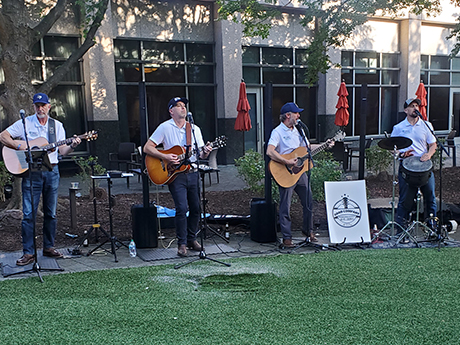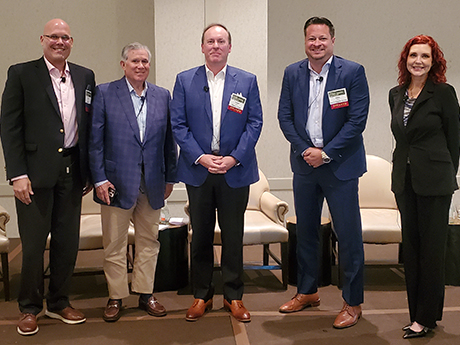By Matt Valley
ATLANTA — In an unsettled world, the capital markets have ironically proven to be relatively stable this year. That’s helped pave the way for the rebound in financing across the seniors housing sector, lenders say. But they are quick to add that construction financing remains difficult to secure for most developers.
For much of this year, the U.S. 10-year Treasury yield has fluctuated between 4.2 and 4.6 percent, a relatively narrow range compared with the high volatility experienced in the three years prior. In 2022, for example, the 10-year yield started the year at approximately 1.5 percent and reached 4.2 percent roughly 11 months later.
Because a large percentage of commercial real estate loans are priced off the 10-year yield, the benchmark rate’s recent stability is significant, say lenders. And there is potentially more good news on the horizon.
“The Fed has been holding steady for several months in terms of short-term rates. But it looks now — based on what Fed Chairman Jerome Powell said last week in his Jackson Hole speech — that the Fed is getting ready to lower rates. The market is pricing in two cuts this year, a total of 50 basis points before the end of the year,” said Aaron Becker, senior managing director of Lument, during the capital markets panel session at InterFace Seniors Housing Southeast in Atlanta on Tuesday afternoon, Aug. 26.
Approximately 300 industry professionals gathered at the Intercontinental Buckhead for the 12th occurrence of the annual conference, which began with a series of roundtables Tuesday and continued Wednesday with multiple panel sessions on a range of topics.
Joining Becker on stage as part of the capital markets panel were Ken Assiran, managing director of seniors housing with Capital Funding Group; Fergal Brady, CFO of Galerie Living; Keith Kodrin, senior managing director with Ikaria Capital Group; and Lisa Silvers, senior vice president and business development officer for Huntington National Bank.
During his speech Aug. 22 in Jackson Hole, Wyoming, as part of the Fed’s Economic Policy Symposium, Powell indicated that the slowing job market might warrant a cut in the federal funds target rate, which is currently is 4.25 to 4.5 percent. A cut in the federal funds rate by the central bank typically leads to lower interest rates for mortgages, car loans and credit cards, making them more affordable for consumers.

Stability Spurs Confidence
When banks encounter interest rate instability — as was the case in 2022, 2023 and much of 2024 — they either sit on the sidelines or become very measured in their approach to financing, said Silvers of Huntington National Bank. In short, banks don’t function well in that type of scenario.
“In 2025, we have seen increased competition [among lenders], and I think that competition comes from the fact that banks can project the future,” noted Silvers, adding that Huntington is anticipating rate cuts this year, for which it can plan for accordingly.
The renewed interest rate stability has created some great opportunities for borrowers, emphasized Silvers. “There’s been price compression, and just that stability [alone] has given sponsors and banks comfort.”
How intense is the competition getting among lenders? Silvers, who operates out of the Miami-Fort Lauderdale region, said she is aware of some deals where debt providers have granted covenant holidays of up to three years for strong sponsors. (A covenant holiday is a temporary waiver or suspension of certain loan covenants that a borrower is required to meet, allowing them to temporarily not comply without triggering a default.)
What’s more, banks have branched out since COVID-19 and are increasingly competing with permanent lenders for deals, noted Silvers in a pitch to borrowers. “If you think in a few years that you might want to sell or refinance or do any number of things, you have that flexibility with the bank, whereas with traditional permanent debt solutions you really don’t. You’re locked in, whether it’s yield maintenance, defeasance or some other form of prepayment [penalty].”
Assiran concurred with Silvers that competition among lenders is heating up. “I think the banks that were lending through COVID and post-COVID — we had the market to ourselves. (Baltimore-based Capital Funding Group has CFG Bank as part of its family of companies.) It was a great environment for the lenders that were active. Now, more capital is coming to the industry and more lenders are getting involved. Things are shifting. Borrowers can push us where we need to compete.”
Apart from new construction, virtually all seniors housing finance deals — ranging from refinancings to agency financings to value-add transactions — have become very competitive, emphasized Assiran. “The spreads are compressing, and it kind of happened relatively quickly.”
Capital Redeployment Underway
Capital has an appetite for a healthy return, and that’s why a growing number of investors are attracted to seniors housing, said Brady of Atlanta-based Galerie Living, a developer and operator of luxury seniors housing communities.
Stung by losses in the office sector and diminishing returns in the tech sector, investors are looking to deploy capital elsewhere, noted Brady. “I read a report the other day that the two top growing sectors are data centers at No. 1 and seniors housing at No. 2.” The strong real estate fundamentals are a big driving factor, he said.
“We all know the metrics. We’ve seen the increased occupancy rates getting up to 89 percent. Rental rates have been pushing up and accelerating. They’ve gone up about 25 percent in the last few years. Last quarter the increase was about 3.5 percent, a little softer than we wanted. We wanted more acceleration [in rental rates] because we still have to pass through initial costs that are there,” explained Brady.
Meanwhile, absorption is outpacing supply. In the second quarter, the annual absorption rate for majority independent living and assisted living communities across the top 31 primary markets tracked by NIC MAP was 3.7 percent compared with annual inventory growth of 1 percent.
“Now we start looking forward through the windshield, and we have huge demand coming at us,” said Brady. “And the question is, what does this demand look like?”
Approximately 15 million adults in the U.S. are at least 80 years old, and the 80-plus population is expected to grow by over 90 percent between 2020 and 2040, according to sources.
Founded in 1996, Galerie Living manages three luxury communities in Georgia under the Village Park brand name: Village Park Peachtree Corners, Village Park Milton and Village Park Alpharetta. The communities offer independent living, assisted living and memory care.
In addition, Galerie manages the ultra-luxury Corso Atlanta in Buckhead, with two other Corso properties under development. Corso Chevy Chase in Chevy Chase, Maryland, is set to open in 2026. Corso Chevy Chase will include 287 independent living dwelling units, 190 assisted living beds and 30 memory care beds, as well as 5,000 square feet of retail that will be open to the public.
Galerie plans to break ground on Corso Druid Hills in Atlanta this fall.
Niche Opportunity
Ikaria Capital Group, launched in 2024, is a privately held company that specializes in financing skilled nursing and seniors housing facilities. Some of the players that Cleveland-based Ikaria is bringing to the table to help finance those transactions include private equity sponsors, hedge funds and endowments, explained Kodrin. “Obviously, the industry has become a growth sector, and these folks want a piece of it. They’re interested in learning more about it.”
Ikaria sees opportunities for these investors to carve out a niche in the capital stack that borrowers rely on when the senior loan is insufficient to fund an acquisition or development. For example, if a bank provides a senior loan, or “A note” as Kodrin likes to call it, these investors can provide the “B note” in the form of preferred equity or mezzanine debt that is subordinate to the senior loan. These investors have a greater risk tolerance and expect a higher return for the additional risk.
There’s plenty of interested parties, emphasized Kodrin. “It’s a matter of getting them comfortable with the space and educating them on the difference between a nursing home and an assisted living community or a seniors housing campus, and just the different areas of underwriting.”
In short, these sophisticated investors need to be educated on what ultimately makes these properties successful, said Kodrin.

Development on the Doorstep?
The availability and cost of labor and the cost of capital are key factors when evaluating new construction opportunities, said Assiran of Capital Funding Group. “It’s not that we as lenders lack a will to do new construction. We’re doing some very large new construction projects, but they’re very high-end projects. They’re with very well capitalized groups and very strong operators. And I think there’s going to be more of that.”
Assiran believes there is going to be a lot of new construction at some point because the demand for it already exists. “Development companies are flexible and there’s a need for new supply. There has been very little new supply added to the marketplace. And it’s going to be very interesting to see what happens in that piece of our lending market.”

